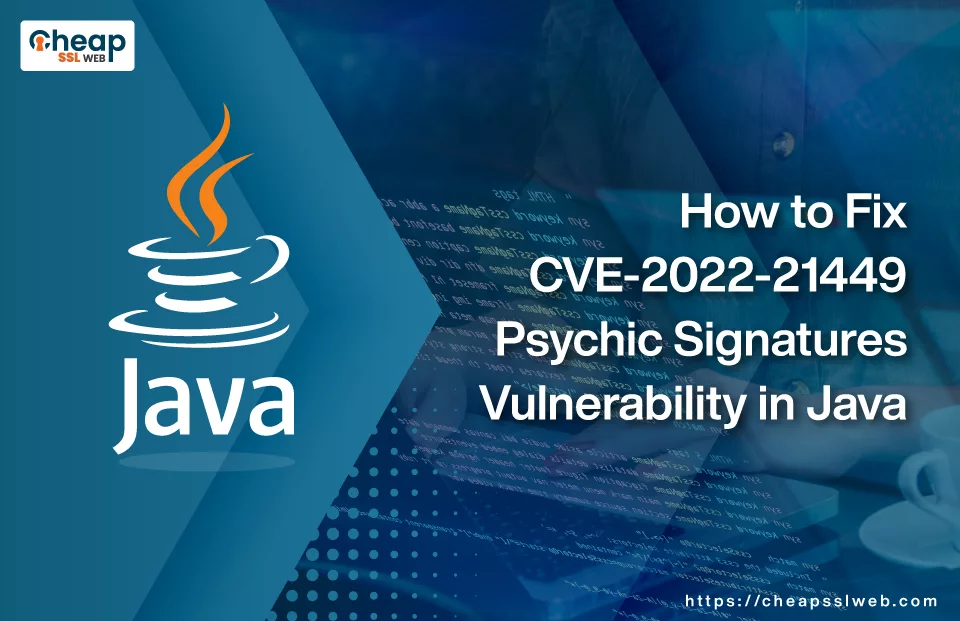How to Fix CVE-2022-21449 – Psychic Signatures Vulnerability in Java

The discovery of – CVE-2022-21449, or the Psychic Signatures issue or vulnerability, has raised alarms in the Java community. Uncovered by security expert Neil Madden, this significant flaw affects Java versions 15, 16, 17, and 18. Its high CVSS score of 7.5 is notable, indicating a severe security risk.
What is a CVE-2022-21449 – Psychic Signatures Vulnerability in Java?
Before we understand or comprehend what exactly the CVE-2022-21449 – Psychic Signatures Vulnerability in Java is, we need to understand the ECDSA (Elliptic Curve Digital Signature Algorithm) signature process. ECDSA relies on two values – r and s, for signature validation. These values, paired with the signer’s public key and the message hash, authenticate signatures.
However, Java’s recent versions overlook a vital check: they don’t verify if r and s are zero. This gap can lead Java to accept a signature with both values at zero, effectively treating a blank signature as valid. Such a loophole can empower attackers to – forge signatures, breach secure systems, and endanger data security.
Moreover, the vulnerability of psychic signatures in Java extends beyond just signature forgery. Hackers exploiting this flaw can bypass crucial security tokens like OIDC ID, SAML assertions, WebAuthn, and signed JWTs (JSON web tokens).
The vulnerability primarily targets digital signatures based on – ECDSA. This means it could enable unauthorized interception and alteration of SSL-encrypted communications and authentication processes.
How do you Resolve the CVE-2022-21449 – Psychic Signatures Vulnerability in Java?
There are three methods that you can use to resolve the Psychic Signatures Vulnerability in Java:
- Update the JDK Version
- Use a Different Signature Algorithm
- Employ SSL Certificates issued by a Trusted Certificate Authority.
Let’s explore each method in depth.
Method 1: Update the JDK Version
Update your Java Development Kit to either one of these versions -17.0.3 or 18.0.1. These versions include Oracle’s patches that close this security gap. Follow the steps mentioned below if you are using a Linux-based system (Ubuntu) to accomplish the same:
- Click Search on the taskbar.
- Type cmd in the search field and select ‘Run as administrator‘.
- The Command Prompt window will appear.
- In the Command Prompt window, type the java -version command. (This command displays the – current version of Java installed on your system.)
- Press Enter.
- If your Java version is below 17.0.3, type the $ wget -no-check-certificate “https://download.oracle.com/java/17/archive/jdk-17.0.3_linux-x64_bin.deb” command in the Command Prompt window.
- Press Enter.
- After the download, type the $ sudo chmod +x jdk-17.0.3_linux-x64_bin.db command to set execution permissions for the downloaded file.
- Press Enter.
- Type the $ sudo apt install /home/arunkl/jdk-17.0.3_linux-x64_bin.deb command to install the Java package.
- Replace /home/arunkl/jdk-17.0.3_linux-x64_bin.deb with the correct path to your downloaded JDK file.
- Press Enter.
- Type the java -version command again in the Command Prompt window to confirm the installation of the new Java version.
- Press Enter.
Method 2: Use a Different Signature Algorithm
If updating Java isn’t an option, consider switching to a different signature algorithm. Use any other ECDSA variations apart from the ones mentioned below:
- SHA256withECDSA
- SHA1withECDSA
- SHA3-256withECDSA
- SHA3-512withECDSA
- SHA1withECDSAinP1363Format
- SHA384withECDSAinP1363Format
- SHA3-512withECDSAinP1363Format
- NONEwithECDSAinP1363Format
- SHA3-256withECDSAinP1363Format
- SHA3-224withECDSAinP1363Format
- SHA256withECDSAinP1363Format
- SHA384withECDSA
- SHA3-224withECDSA
- SHA512withECDSA
- SHA224withECDSA
- NONEwithECDSA
- SHA512withECDSAinP1363Format
- SHA3-384withECDSA
- SHA224withECDSAinP1363Format
- SHA3-384withECDSAinP1363Format
Method 3: Employ SSL Certificates issued by a Trusted Certificate Authority
Opt for certificate authorities known for their rigorous validation processes and strong reputation. Some of the most trusted CAs in the market include Certera, Comodo, and Sectigo. These CAs offer “n” number SSL certificates, catering to different security needs and budget constraints.
Here are some of the most popular SSL certificates that you can purchase:
Conclusion
Addressing the CVE-2022-21449 – Psychic Signatures Vulnerability in Java is paramount for safeguarding your systems whereby implementing any of these Three effective methods to mitigate this risk offers a robust solution to enhance security and protect against potential data breaches.
